
Pittenweem ( ) is a fishing village and civil parish in Fife, on the east coast of Scotland. At the 2001 census, it had a population of 1,747.

MacLellan's Castle in the town of Kirkcudbright, in Galloway, Scotland, was built in the late 16th century. It stands in the centre of Kirkcudbright, on the south side of the River Dee which flows into the Solway Firth. The L-plan castle was the residence of the MacLellan family from whom it derived its name. The family sold the castle in 1752, and from 1782 to 1912 it was held by the Earls of Selkirk. Today, the site is curated by Historic Environment Scotland.
David MacGibbon and Thomas Ross were Scottish architects. Their practice, MacGibbon and Ross was established in 1872 and continued until 1914. They are best known today for their comprehensive published surveys of Scotland's architectural heritage.

Fordell Castle is a restored 16th-century tower house, located 1.25 miles (2.01 km) north-west of Dalgety Bay and 2 miles (3.2 km) east of Dunfermline, in Fife, Scotland. Parts of the castle date from before 1566, though most dates from 1580 or later. The chapel was rebuilt in 1650. The interior of the castle was substantially renovated in the 1960s, with additional major renovations to the castle interiors and chapel in the early 2000s. The estate is in private ownership and not available for public tour.
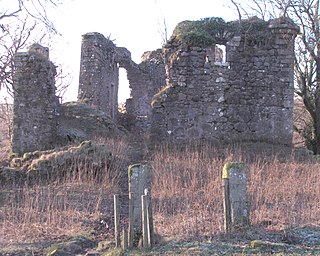
Glengarnock Castle is one of the ancient ruined fortifications of Ayrshire. Its keep is located on a remote rocky promontory overlooking the River Garnock about 2 miles (3.2 km) north of the town of Kilbirnie in North Ayrshire, Scotland. There is no clear account of when this was erected or by whom, but it may have been built by the Cunningham family or by the Riddels who preceded them. The Barony of Glengarnock is one of three feudal baronies which together form the parish of Kilbirnie in the district of Cunningham which lies in north Ayrshire. The River Garnock flows through the village of the same name 4 kilometres (2.5 mi) to the south, but the name Glen Garnock applies more specifically to the ravine at Glengarnock Castle.

Carrick Castle is a 14th-century tower house on the west shore of Loch Goil on the Cowal peninsula in Argyll and Bute, Scotland. It is located between Cuilmuich and Carrick, 4 miles (6.4 km) south of Lochgoilhead.
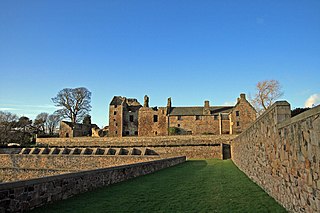
Aberdour Castle is in the village of Easter Aberdour, Fife, Scotland. Parts of the castle date from around 1200, making Aberdour one of the two oldest datable standing castles in Scotland, along with Castle Sween in Argyll, which was built at around the same time.
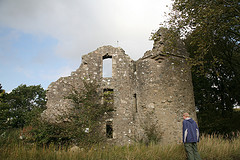
Esslemont Castle is a ruined tower house in Aberdeenshire, Scotland. It is located on the A920 west of Ellon and is designated a scheduled ancient monument.

Creich Castle is a ruined tower house near Creich, Fife, Scotland. The tower house and its associated buildings is a scheduled monument. There is a mention of a castle on the property in the 13th century, but it is uncertain what relationship that has to the existing structures. There is documentary evidence of a tower in 1553, but the existing structure either postdates that or has been heavily remodeled, judging by its architectural style.
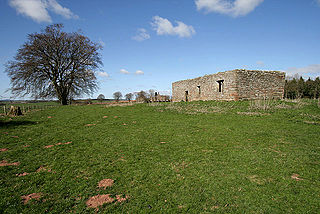
Bassendean is a village in the Scottish Borders area of Scotland, 4 kilometres (2.5 mi) south of Westruther and 3 kilometres (1.9 mi) north-west of Gordon. It is by the Eden Water in the former Berwickshire, immediately south of the hamlet of Houndslow.

Knockdavie Castle is a now-ruined 17th-century house in Burntisland parish, Fife, Scotland. The name probably derives from the Gaelic cnoc dubh -in "(place of the) black hill(ock)", with cnoc dabhoch “the hill farm” another theory. It is recorded under the alternative name of Stenhouse in 1561, which survives in the name of the modern day adjacent farmhouse. It is said to have belonged, in the seventeenth century, to a Douglas, recorded in an appendix to The Scots Worthies as an opponent of the Covenanters.

Ochiltree Castle is a 16th-century tower house a few miles south east of Linlithgow in West Lothian, Scotland. It is also described as a farmhouse and lairds house. Along with its boundary wall, the castle was designated as a Category A listed building in 1971.

Barra Castle is an unusual L-plan tower house dating from the early 16th century, about two miles south of Oldmeldrum, above the Lochter Burn, in the parish of Bourtie, Aberdeenshire, Scotland. It occupies the site of the Battle of Inverurie (1308), in which Robert Bruce defeated John Comyn, Earl of Buchan.

Bonhard Castle was an L-plan tower house, dating from the 16th century, around 1.5 miles (2.4 km) south east of Bo'ness, in West Lothian, Scotland. It was demolished in 1962.

Dalcross Castle is a restored 17th century tower house, about 1+1⁄2 miles southwest of Croy, Highland, Scotland, and about 7 miles northeast of Inverness. The castle stands on a ridge.
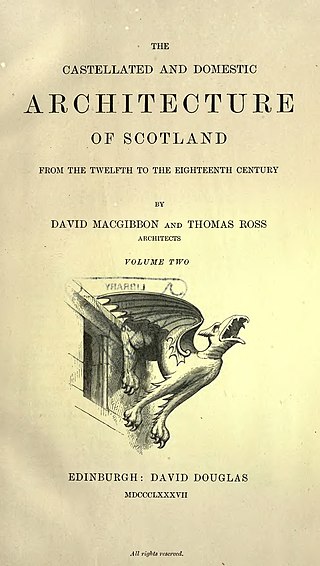
The Castellated and Domestic Architecture of Scotland from the Twelfth to the Eighteenth Century is a book that was published in 5 volumes from 1887 to 1892 by Scottish architects David MacGibbon and Thomas Ross.
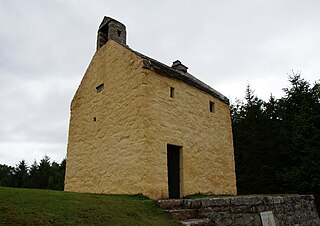
Ardclach Bell Tower is an historic structure in Ardclach, Scottish Highlands. Dating to at least 1655, it is now a Category A listed building. It is believed to be the only tower and belfry combination in Scotland.

Crail Tolbooth and Town Hall is a municipal structure in Crail, Fife, Scotland. The building, which stands in Marketgate, at its junction with Tolbooth Wynd, is Category A listed.

Pittenweem Parish Church and Tolbooth Steeple is an ecclesiastical and municipal complex in the High Street, Pittenweem, Fife, Scotland. The structure, which is used as the local parish church, is a Category A listed building.





















